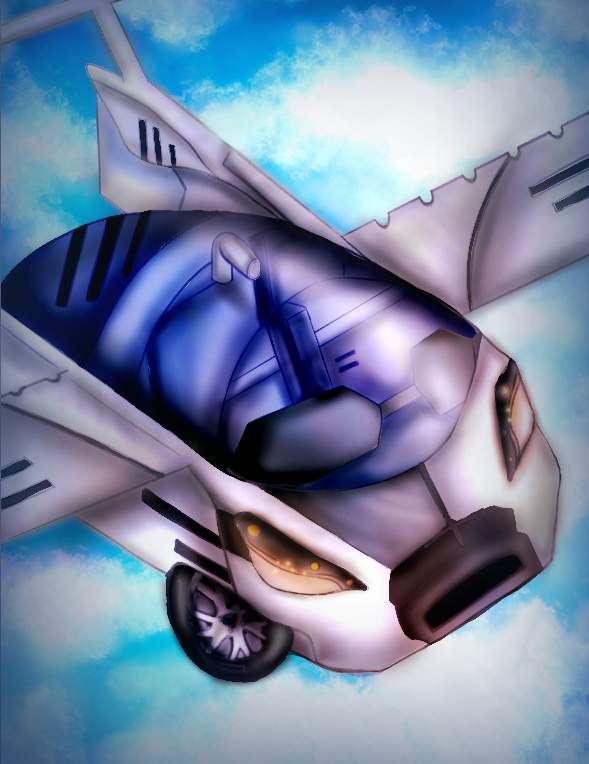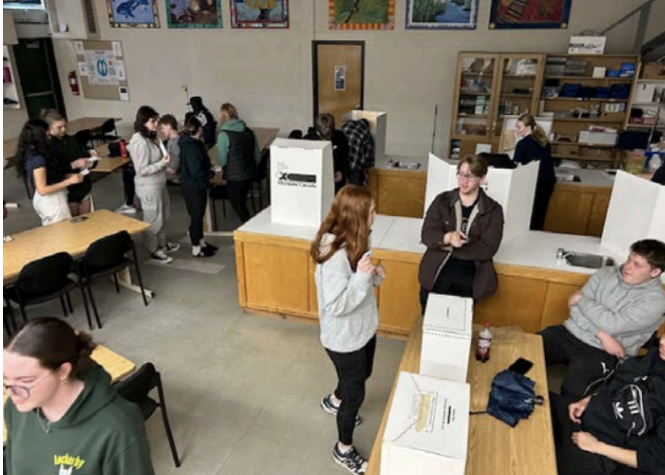
translated by Chanseok Hwang (ASD Grade 10)
written by Seungwoo Shin (NLCS Dubai G6)
[The Technology of Tomorrow: Flying Cars]
The invention of the Automobile has allowed humans to travel faster to any desired destination. Following the introduction of the gasoline-car from Mercedes-Benz, cars with various designs and functions have been released to the world, and they have become one of the most essential means of transportation. Currently, with a total of 21.8 million cars, 2 out of 5 people in South Korea own an automobile. Even so, with the increasing amount of vehicles, traffic congestion has cost Korea alone over 30 trillion won (approx. 27 billion USD), and stress levels have increased by 60% while driving. However, in the near future, these traffic congestion issues may be mitigated by new vehicles: flying cars.
A flying car is a car that runs mostly on road but can also transform to flight-mode at the driver’s will. In short, flying cars allow one to travel both in the sky and on land. Indeed, there are three ways a flying car can take off and land: VOTL (vertical takeoff), COTL (takeoff via runway) and STOL (short-distance takeoff and landing). Depending on the capabilities of the vehicle, the appearance of a flying car can change a lot. For instance, because VOTL cars take off and land vertically, they’re designed similarly to drones. As for COTL cars, they resemble airplanes, and SOTL cars can be designed as a mixture of airplanes and drones. In fact, many countries are making great efforts to commercialize flying cars, such as the Dutch company Pal-V. Pal-V has been receiving pre-purchases from customers for two years now and are preparing to promote and commercialize the Pal-V1 model.
Pal-V1 is made of carbon fiber, titanium, and aluminum – all of which allows it to excel in terms of lightness and stability. In addition, a number of Korean companies, such as Hyundai, SKT, and Hanwha systems, are promoting the development of flying cars. Hyundai has introduced a flying car with Uber Technologies at CES2020, and SKT is currently trying to create a navigation system for flying vehicles, equipped with 5G, artificial intelligence, and high definition. Finally, Hanwha Systems has invested almost 30 billion won (appox. 27 million USD) in Uber to accelerate the flying taxi industry, and together they have already unveiled ‘Butterfly’, an air taxi, at the Urban Air Traffic Seoul Demonstration last year.
Flying cars have the advantage of mitigating traffic congestion, but there are also disadvantages: accidents at about 500 feet above the ground can be devastating. In the case of the Pal-V, it uses one engine while driving and two engines while flying. Since automobile engines and airplane engines have different structures and functions, after wondering how to convert the mechanical energy into thrust-power, the company decided to use both of the engines as they were. This added to the safety of the vehicle, since it was possible to use two engines while flying. On the other hand, there was a problem with the center of gravity: the center of gravity was concentrated downwards since cars travel on the ground. Yet, because the center of gravity of an airplane is located higher near the forefront, there was a big obstacle in switching between land-mode and flight-mode. Therefore, in order to solve this, flexible carving systems have been deployed, and sensors that balance the center of gravity have been implemented.
If flying cars are commercialized, many transportation policies must be changed, and regulations for flying cars must be defined. Although there are current laws, they are mostly insufficient. For example, there needs to be regulations that state the minimum altitude of flying cars as 500 feet, and that it must be driven with an aircraft control license. Another problem revolves around the runway space that a flying car needs to take off. If the flying car is a VTOL, it doesn’t matter much, but most flying car manufacturers use the STOL model that requires a runway space of at least 200 meters, meaning that if the space to switch from land-mode to flight-mode isn’t available, traffic congestion will stay as it is. This is mainly because when there isn’t much space, or distance, between cars in a congested road, wings and propellers may collide with nearby vehicles during takeoff. Also, while there are legal permits allowing takeoff for homes that have a 15 by 100 meter runaway space, the majority of people don’t, which means that runaway spaces will need to be publicized as municipal facilities.
Another problem that needs consideration is the noises and vibrating sounds from flying cars while in operation, along the air-pollution that they can cause. While using flying cars may reduce traffic congestion, it can worsen pollution. Thus, it is necessary to limit fuels such as gasoline that cause pollution, or to establish eco-friendly regulation policies.
Urban aviation mobility systems will be very beneficial if mass produced, cost reduced, and aligned with government protocols. Not only will people have access to a new mode of transportation, traffic congestion on roads will be alleviated to some extent. However, it is important to note that similar problems, as on land, may occur (such as drunk driving), and the repercussions would be much worse at such a dangerous altitude. Additionally, there aren’t any international laws that regulate flying cars, which means that a new set of codes need to be established or reformed. Since flying car licenses have not yet been issued, light-aircraft licenses have substituted their absence; however, the two are very different, so a new flying-car license must be made. Korea, too, is a country that leads in the automobile industry, and we must continue this interest in flying cars, which will be the innovative breakthrough technologies in the next generation.
[하늘을 나는 자동차]
written by Seungwoo Shin (NLCS Dubai G6)
자동차의 발명 이후, 사람들은 더욱 빠르게 어디든지 갈 수 있게 되었다. 벤츠 사의 가솔린 자동차가 세상에 나오게 되면서 다양한 디자인과 성능을 지닌 자동차가 출시되었고, 자동차는 가장 필수적인 이동 수단 중 하나가 되었다. 현재 대한민국의 차 대수는 약 2180만대로 국민 5명 중 2명이 차를 가지고 있다. 하지만 많은 차로 인해 발생하는 교통혼잡비용이 대한민국에서만 30조 원이 넘으며, 교통체증 시 스트레스가 60%나 상승한다고 한다. 그러나, 가까운 미래에는 이러한 교통체증이 어느 정도 감소할 수 있다. 왜냐하면 바로 플라잉 카 때문이다.
플라잉 카란 평소에는 달리다가 운전자가 원할 때 비행모드로 바꿀 수 있는 차이다. 한마디로, 하늘과 땅 둘 다 다닐 수 있는 이동 수단이다. 플라잉 카는 3가지의 이착륙 종류가 있는데, 이는 VOTL( 수직으로 이륙), COTL( 활주로를 통해 이륙) 그리고, STOL(단거리 이착륙)이다. 어떤 종류를 선택하는 데에 따라 플라잉 카의 외관도 많이 바뀐다. VOTL은 수직으로 이착륙을 하므로 드론과 비슷하게 디자인이 되고, COTL은 비행기와 많이 닮았고, SOTL은 비행기와 드론이 섞여있는 모습이다. 현재 많은 나라에서 플라잉 카를 상용화하려고 많은 노력을 기울이고 있는데, 그 예가 네덜란드의 Pal-V사이다. Pal-V사는 2년 전부터 고객들에게 사전 구매를 하였고, 상용화를 준비하고 있다. Pal-V사가 내세우고 있는 플라잉 카는 Pal-V1이다. Pal-V1은 카본 섬유, 티타늄, 알루미늄 등으로 이루어져 있어 가벼움과 견고함의 두 마리의 토끼를 잡았다. 또한, 우리나라에서도 플라잉 카 개발을 추진하고 있는데, 그 선두에 있는 기업들은 바로 현대, SKT, 한화 시스템 등이 있다. 현대는 CES2020에서 우버 테크놀로지와 함께 플라잉 카를 선보였고, SKT는 5G, 인공지능, 고화질이 탑재된 내비게이션을 만들려고 노력 중이다. 한화 시스템은 우버에 300억 원을 투자하여 플라잉 택시 산업에 동참하여 작년에 열린 도심 항공교통 서울 실증 행사에서 에어택시인 버터플라이를 공개하기도 있다.
플라잉 카는 교통체증을 완화시킬 수 있는 장점이 있으나, 단점도 있다. 바로 기술적인 문제인데, 약 500피트 상공에서 사고가 발생하면 대처하기 힘들어질 수 있다. Pal-V사의 경우, 운전을 할 때는 한 엔진만 사용하고 비행할 때는 두 대를 함께 사용한다. 자동차 엔진과 비행기 엔진은 구조와 기능이 다르기 때문에 엔진의 동력을 추력으로 바꾸는 방식을 고민하다 두 개의 엔진을 그대로 사용하는 방법을 채택했다. 장점은 주행에는 하나의
엔진이 쓰이고 비행할 때는 안전성을 추가하기 위해 두 개의 엔진을 같이 사용하게 하였다. 또 다른 문제는 무게중심인데, 자동차는 땅에서 다니므로 무게중심이 아래로 집중되어 있다. 그러나, 비행기는 무게중심이 위에 있으므로, 자동차 모드와 비행모드로 전환할 때 가장 큰 걸림돌이 된다. 그래서 가변형 carving system을 활용해서 유연하게 옮기는 방법이 사용되기도 하고, 무게중심을 잡아주는 센서를 넣기도 하면서 해결하고 있다.
플라잉 카가 상용화가 된다면, 많은 교통정책이 변화되어야 하고, 플라잉카에 대한 규정이 생겨야 한다. 플라잉 카에 대한 규정들은 있긴 하나 아직 미흡하다. 예를 들자면, 플라잉 카는 최소 높이를 500피트 이상으로 날 수 있어야 하고, 경비행기 조종 면허로 운전할 수 있다는 정도이다. 또 다른 문제는 플라잉 카를 날개 할 수 있는 활주로 공간의 문제다. 플라잉 카가 VTOL이라면 크게 문제가 되지 않지만 거의 대부분의 플라잉 카 제조사들은 STOL을 사용하므로 최소한 200미터의 활주로가 있어야 하고 또한 교통체증이 지속되는 지역에서 바로 비행모드로 변할 수 없을지도 모른다. 왜냐하면 차가 막힐 때는 차간 거리가 짧기 때문에 날개나 프로펠러를 피는 와중에 다른 차들과 충돌할 수 있기 때문이다. 또한, 집에 가로 15미터, 세로 100미터의 공간이 있으면 개인이 활주로를 소유할 수 있는 더크 퍼미션이라는 게 있지만, 모든 사람들이 그렇지 못하므로 최소한 도시 단위로 공용 활주로가 필요하고, 또한 관제 시스템 등이 추가되어야 한다. 또 다른 조건은 플라잉 카가 이착륙을 할 때 나는 소음이나, 연료를 사용하는 과정에서 나오는 공해 등을 해결해야 된다. 플라잉 카를 사용하면서 교통체증은 줄어들 수도 있지만, 공해를 더욱 심각하게 할 수도 있다. 이 같은 문제를 해결하기 위해서는 공해를 유발하는 휘발유 같은 연료를 제한하거나, 친환경 에너지 규제 정책을 마련해야 한다.
도심 항공 모빌리티는 양산화와 비용 절감, 정부와 지자체, 민간기업과의 호흡이 잘 진행된다면 아주 유용할 것이다. 왜냐하면 사람들에게 또 다른 하나의 교통수단이 생기고 그렇게 되면은 지상에 있는 교통체증이 어느 정도 완화될 것이기 때문이다. 그러나, 유의할 점은 자동차와 같이 음주운전 문제도 발생할 수 있고, 공중에 있으므로 더 많은 피해를 가져올 수도 있다. 또한, 플라잉 카에 대한 국제적 기준과 부품들의 규정들은 없기 때문에 플라잉 카를 만드는 데에 썼던 부품 중 하나가 규정에 위반된다면 다시 만들어야 한다. 아직 플라잉 카의 면허가 발행되지 않아서 경비행기 면허증을 플라잉 카의 면허증 대용으로 쓰고 있지만 경비행기와 플라잉 카는 작동 방식이 달라서 빨리 전문 운전면허증을 개발해야 한다. 우리나라도 자동차를 잘 만드는 나라로 차세대 모빌리티 혁명의 주역이 될 플라잉 카에 대한 관심과 기술 발달을 서둘러야 한다.





